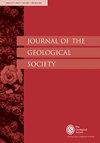北极高地大型火成岩区:北冰洋中部罗蒙诺索夫海脊多个中生代火山脉冲的第一个地震地层证据
IF 3
3区 地球科学
Q2 GEOSCIENCES, MULTIDISCIPLINARY
引用次数: 0
摘要
我们使用冬季探险队在北冰洋中部漂移的海冰上获得的地震反射数据,来探索北冰洋深处部分海底地质与弗兰兹-约瑟夫地和斯瓦尔巴群岛岛屿和边界大陆架上发现的中生代火山岩之间可能的时空岩浆关系?来自北冰洋中部罗蒙诺索夫海脊北美段(85°–90°N)的新数据记录了沿海脊600公里范围内的几个中生代火山脉冲。这种火山活动与深盆中邻近的阿尔法山脊上的高磁场强度区域接壤,那里的磁源岩和最近的地震反射数据表明存在广泛的中生代岩浆活动。我们认为,罗蒙诺索夫山脊位于弗朗茨·约瑟夫地和斯瓦尔巴群岛以北的前大陆边缘的古位置上的中生代火山活动在空间上将极地欧洲大陆高北极大型火成岩省(HALIP)的中生代岩浆脉冲与北冰洋深处相邻的阿尔法山脊上的火山活动联系起来。罗蒙诺索夫山脊上地壳热量输入的增加促进了烃源岩的成熟,这表现在火山活动区域内存在的气体/流体逸出管。本文章由计算机程序翻译,如有差异,请以英文原文为准。
The High Arctic Large Igneous Province: first seismic-stratigraphic evidence for multiple Mesozoic volcanic pulses on the Lomonosov Ridge, central Arctic Ocean
We use seismic reflection data acquired by a winter-over expedition on drifting sea ice in the central Arctic Ocean to explore a possible spatial and temporal magmatic relation between the sub-bottom geology of part of the deep Arctic Ocean and the Mesozoic volcanic rocks found on the islands and the bordering continental shelf of Franz Josef Land and Svalbard? The new data set from the North American segment (85
o
– 90
o
N) of the Lomonosov Ridge, central Arctic Ocean documents several Mesozoic volcanic pulses over a distance of ˞600 km along the ridge. This volcanism borders a domain of high magnetic field intensity over the adjacent Alpha Ridge in the deep basin where the magnetic source rocks and recent seismic reflection data indicate extensive Mesozoic magmatism. We suggest the Mesozoic volcanism on the Lomonosov Ridge in its paleo-position at the former continental margin north of Franz Josef Land and Svalbard spatially link the Mesozoic magmatic pulses of the continental High Arctic Large Igneous Province (HALIP) of polar Europe to volcanism on the adjacent Alpha Ridge in the deep Arctic Ocean. Increased input of heat to the upper crust on the Lomonosov Ridge enhanced maturation of hydrocarbon source rocks as manifested by the presence of gas/fluid escape pipes restricted to the area of volcanism.
求助全文
通过发布文献求助,成功后即可免费获取论文全文。
去求助
来源期刊

Journal of the Geological Society
地学-地球科学综合
CiteScore
6.00
自引率
3.70%
发文量
68
审稿时长
6-12 weeks
期刊介绍:
Journal of the Geological Society (JGS) is owned and published by the Geological Society of London.
JGS publishes topical, high-quality recent research across the full range of Earth Sciences. Papers are interdisciplinary in nature and emphasize the development of an understanding of fundamental geological processes. Broad interest articles that refer to regional studies, but which extend beyond their geographical context are also welcomed.
Each year JGS presents the ‘JGS Early Career Award'' for papers published in the journal, which rewards the writing of well-written, exciting papers from early career geologists.
The journal publishes research and invited review articles, discussion papers and thematic sets.
 求助内容:
求助内容: 应助结果提醒方式:
应助结果提醒方式:


